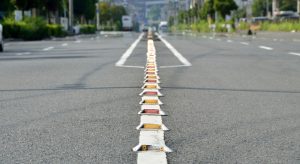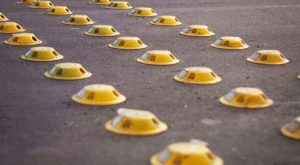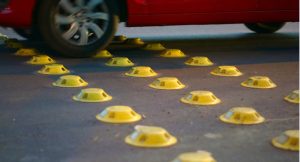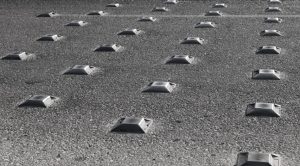Motorway driving is an essential skill for many drivers in the UK. It’s a feature of our roads that requires not only confidence but also a strong understanding of the safety measures in place.
Among these safety measures, reflective studs play a crucial role in guiding drivers, especially in low-visibility conditions such as nighttime or adverse weather.
In this article, I’ll explain about where are amber reflective studs found on a motorway and the significance of amber reflective studs on UK motorways, their exact placement, and how they contribute to road safety.
What Are Reflective Studs on Motorways?

Reflective studs, commonly referred to as “cat’s eyes,” are small devices embedded in the road surface to help guide drivers. They were first introduced in the 1930s by Percy Shaw, an inventor from Yorkshire, who was inspired by how light reflected off a cat’s eyes in the dark.
These studs have become a staple of road safety across the UK, offering enhanced visibility and navigation cues for motorists. Each reflective stud is designed to serve a specific purpose, with its color denoting its function.
Amber, red, green, white, and fluorescent green/yellow are the primary colors used, and each one is strategically placed to give drivers critical information about lane boundaries and road features.
The studs are built to endure harsh weather conditions and the heavy loads of motorway traffic. Modern advancements have even introduced solar-powered variants that provide even greater visibility and durability.
Where Are Amber Reflective Studs Found on a Motorway?
Amber reflective studs are specifically located along the central reservation of motorways. The central reservation is the divider that separates traffic traveling in opposite directions.
The amber color ensures high visibility, helping drivers identify the reservation even in low-light conditions. The placement of amber studs is not arbitrary. These markers are crucial for maintaining safety on high-speed roads, where losing control or drifting into the opposite lane could have catastrophic consequences.
Amber studs serve as a constant visual reminder to drivers, ensuring that they stay in their designated lanes.
Imagine driving on a dark motorway where the lanes are not clearly visible due to fog or rain. In such conditions, amber studs act as a beacon, providing reassurance that you are navigating within the correct boundaries.
Their reflective surface catches the light from your vehicle’s headlights, making them easy to spot and follow.
Why Are Amber Reflective Studs Important?

The importance of amber reflective studs lies in their ability to prevent accidents and enhance road safety. They are designed to stand out under all conditions, whether it’s a bright sunny day, a misty morning, or a rainy night.
For instance, on a rainy evening, when visibility is reduced, a driver might find it challenging to discern the road layout. Amber studs guide the way, reducing confusion and the likelihood of crossing into oncoming traffic.
Their ability to reflect light ensures that drivers can clearly see the division between opposing lanes, even when other road features are obscured.
Furthermore, amber studs help reduce driver fatigue. On long journeys, the repetitive and predictable placement of these markers provides a sense of orientation, keeping drivers alert and focused.
By clearly delineating the central reservation, amber studs significantly lower the risk of head-on collisions, one of the most dangerous types of road accidents.
Understanding Other Reflective Stud Colors

Reflective studs come in various colors, each serving a unique purpose. These markers collectively create a visual roadmap for drivers, ensuring that every part of the motorway is well-defined.
- Red Studs: These are placed along the left edge of the carriageway, marking the boundary between the motorway and the hard shoulder. Their bright red color serves as a warning, reminding drivers to stay within their lane unless it’s an emergency.
- Green Studs: Found at slip roads and lay-bys, green studs indicate areas where vehicles can leave or join the motorway. They provide clear guidance for merging traffic, reducing confusion and the risk of accidents.
- White Studs: These are used to separate lanes within the motorway. They help drivers maintain their position in their designated lane, ensuring smooth traffic flow.
- Fluorescent Green/Yellow Studs: These are temporary markers used during roadworks. Their bright color makes them highly visible, even during the day, ensuring that drivers are aware of altered road layouts.
The Evolution of Reflective Studs on Motorways
Reflective studs have come a long way since their invention. When Percy Shaw introduced cat’s eyes, they were simple yet revolutionary. These early versions relied on glass lenses and rubber housings to provide basic reflection.
Over the decades, advancements in materials and technology have made them more durable and effective.
In the 1950s, reflective studs became a standard feature on UK motorways. Modern studs now incorporate advanced reflective materials and solar-powered lighting, making them visible from greater distances and in more extreme conditions.
The evolution of these devices reflects the ongoing commitment to road safety and innovation.
Common Misconceptions About Reflective Studs
Despite their widespread use, there are several misconceptions about reflective studs.
One common myth is that all reflective studs serve the same purpose. In reality, each color conveys a specific message to drivers, from lane boundaries to exit points. Amber studs, for example, are unique to the central reservation and cannot be used elsewhere.
Another misconception is that reflective studs are ineffective in heavy rain. While water can reduce their brightness slightly, the materials used in their construction are designed to perform well in wet conditions.
Maintenance and Technology Behind Amber Reflective Studs

The durability and effectiveness of amber reflective studs are essential for maintaining road safety. These studs endure constant exposure to weather, traffic, and wear, making regular maintenance and technological innovation critical.
Maintenance Procedures
Reflective studs are subject to periodic inspections by highway maintenance teams. The process involves:
1. Cleaning:
Dirt, oil, and debris from the road can accumulate on the studs, diminishing their reflectivity. Specialised cleaning equipment is used to restore their clarity and visibility.
2. Replacement:
Over time, studs may become worn or damaged due to heavy traffic, particularly on high-speed motorways. Maintenance teams replace these studs promptly to ensure uninterrupted guidance for drivers.
3. Damage Assessment:
After severe weather events or accidents, inspections are carried out to identify and repair any damage to road infrastructure, including reflective studs.
The efficiency of this maintenance is a testament to the UK’s commitment to road safety. Without these regular checks, drivers would face greater risks, especially during nighttime or poor weather conditions.
Advances in Reflective Technology
Technological innovations have significantly enhanced the functionality of amber reflective studs. Some of the advancements include:
1. High-Visibility Materials:
Modern studs use advanced reflective materials that remain bright even under minimal lighting. These materials are often made from durable plastics or metal alloys, ensuring long-lasting performance.
2. Solar-Powered Studs:
Solar-powered reflective studs are an emerging technology that charges during the day and emits a continuous glow at night. These studs are particularly useful in areas with minimal street lighting, providing an extra layer of safety for drivers.
3. LED-Embedded Studs:
Some motorway studs now include LED lights that offer superior visibility compared to traditional reflective surfaces. These lights can be programmed to flash or change colors to alert drivers to specific road conditions.
By combining robust maintenance protocols with cutting-edge technology, amber reflective studs continue to evolve, enhancing their role as a critical safety feature on UK motorways.
Tips for Recognising Amber Studs While Driving
Recognising amber reflective studs is an essential skill for navigating motorways safely. These studs are strategically placed along the central reservation to separate opposing traffic flows, but spotting them requires attention and awareness, particularly in challenging conditions.
1. Look for Amber Studs at Key Locations
Amber studs are always positioned along the right-hand side of your lane when driving on the left-hand carriageway. They delineate the central reservation and provide clear guidance, especially in low-visibility situations such as fog or heavy rain.
2. Adjust Your Headlights for Optimal Visibility
Using dipped headlights at night or in adverse weather is crucial for illuminating reflective studs without creating glare. High beams can overpower the reflective surface, making the studs harder to see. Dipped headlights focus the light closer to the road, enhancing visibility.
3. Stay Vigilant in Adverse Weather Conditions
Amber reflective studs are particularly helpful in rain or fog, where road markings might be obscured. Train your eyes to identify the amber color, which stands out against the dark road surface, and use these studs as a guide to ensure you remain within your lane.
4. Avoid Distracted Driving
Distractions such as mobile phones, loud music, or engaging conversations can make it easy to overlook important road features. Stay focused on the road and use amber studs as a reference point when navigating bends or merging with other traffic.
By making these practices a habit, you’ll not only recognise amber reflective studs more effectively but also become a safer and more confident motorway driver.
Rules and Guidance for Drivers on UK Motorways

The Highway Code provides comprehensive guidelines by driving instructor on UK motorways, ensuring that all motorists understand their responsibilities and the safety measures in place. Reflective studs, including amber ones, are a critical part of these rules.
1. Understanding the Role of Reflective Studs
Reflective studs are an integral feature of motorway safety. The Highway Code emphasises that:
- Amber studs mark the central reservation.
- Red studs highlight the left edge of the carriageway.
- Green studs indicate entry and exit points such as slip roads.
By adhering to these color-coded markers, drivers can stay oriented, even on unfamiliar motorways.
2. Speed and Lane Discipline
Motorways are designed for high-speed travel, but speed limits must always be respected. Reflective studs play a key role in maintaining lane discipline. For example:
- White studs separate lanes, helping drivers stay within their designated path.
- Amber studs ensure that drivers remain on their side of the central reservation, preventing head-on collisions.
Maintaining your lane and following the guidance of these markers helps avoid sudden lane changes and dangerous driving behavior.
3. Preparing for Motorway Driving
For new drivers, motorway driving can seem overwhelming. The following steps can help build confidence:
- Learn the Basics: Before venturing onto a motorway, study the Highway Code to understand the role of reflective studs and other safety features.
- Practice with an Instructor: Consider taking a motorway driving lesson with a qualified instructor who can guide you through best practices.
- Plan Your Journey: Use navigation tools to familiarise yourself with the route, including entry and exit points. Green reflective studs will help you identify these areas during the journey.
4. Dealing with Roadworks and Temporary Adjustments
Motorway roadworks often introduce temporary changes to lane layouts. Fluorescent green/yellow reflective studs are used to mark these temporary adjustments.
Drivers must remain alert, reduce their speed, and follow the guidance provided by these studs and accompanying road signs.
5. Emergency Situations
In emergencies, the left-hand hard shoulder marked by red studs provides a safe area to stop. However, drivers should only use the hard shoulder if it’s an absolute necessity, such as a mechanical breakdown or a medical emergency.
By adhering to these rules and recognising the guidance provided by reflective studs, you can navigate motorways with confidence and safety.
Conclusion
Amber reflective studs are a small but essential feature of UK motorways, providing guidance and enhancing safety for all drivers. By understanding their placement and purpose, we can navigate motorways more confidently and reduce the risk of accidents.
Whether you’re a new driver or a seasoned motorist, staying informed about these features will make your journeys safer and more efficient.
FAQs
What do amber reflective studs indicate on a motorway?
Amber reflective studs mark the central reservation, helping drivers identify the division between opposing lanes.
How do amber reflective studs differ from red studs?
Amber studs indicate the central reservation, while red studs mark the left edge of the carriageway.
Are reflective studs effective in poor weather?
Yes, reflective studs are designed to remain visible in fog, rain, and other adverse conditions.
What is the role of green reflective studs?
Green reflective studs mark slip roads, lay-bys, and motorway exits, providing clear guidance for merging or leaving traffic.
How can I ensure safe motorway driving at night?
Familiarise yourself with reflective stud colors, use dipped headlights, and stay within your lane using the studs as a guide.
Are amber reflective studs used globally?
Reflective studs are used worldwide, but the color coding and placement may vary by country.
How often are reflective studs maintained?
Reflective studs are regularly inspected and cleaned to ensure they remain visible and functional.




